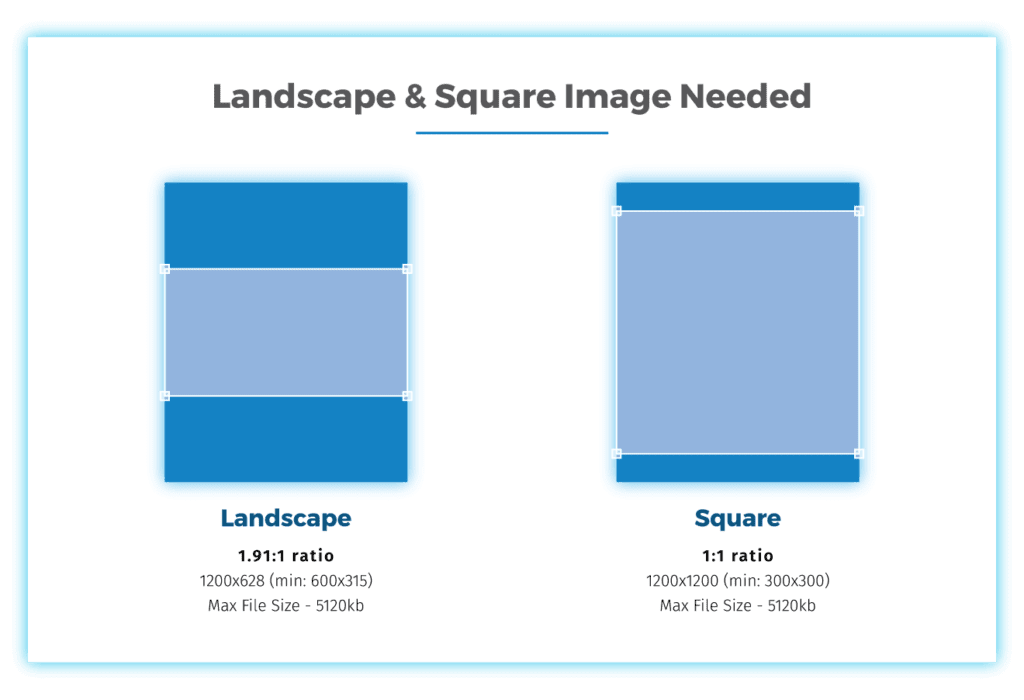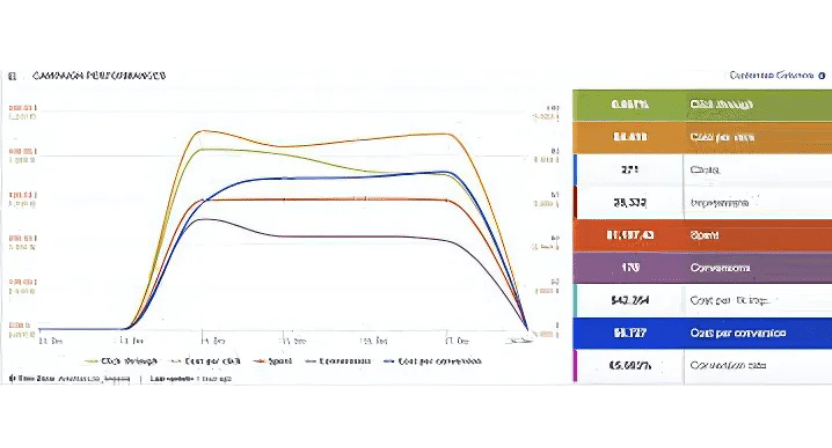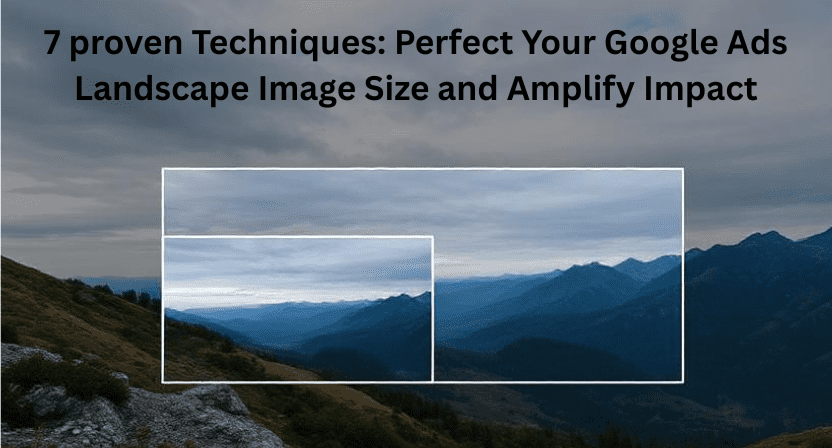Table of Contents
The visually dominant nature of digital advertising relies on images as transformative cornerstones to develop captivating advertisement content. Your visuals must connect with target customers through proper selection of {google ads landscape image size}. This piece explores seven tested methods for improving landscape picture sizes that create better ads and generate higher conversion rates.
Introduction: The Visual Power of Landscape Images in Google Ads
Landscape images in Google Ads provide an extensive space to display your business products or services while narrating your brand narrative. Google Ads landscape image size requirements matter because they determine both your ad performance and image quality delivery. The following guide will fully explain how to achieve mastery over landscape image dimensions when using Google Ads.

1. Google Ads requires users to understand the landscape image size specifications needed for optimal Results.
Landscape images within Google Ads need specific dimensions for the best visual display across all available advertisements across different devices.
Key Principles :
The appropriate dimensions for landscape images should measure 1200 x 628 pixels at a 1.91:1 ratio aspect. When images have this specific measurement they show in a sharp and non-distorted manner.
For different ad placements you can use the alternate square image dimension of 1200 x 1200 pixels while maintaining file size under 5MB.
The recommended landscape photo formats include PNG or JPG files. The two available file formats provide both excellent compression rates as well as high image qualities.
Images should have file sizes below 5MB since bigger files delay ad loading times and raise the risk of disapprovals.
Performance issues might be linked to image size when you review your data through a {google ads report template}.
Expanded Explanation:
Attaining these requirements helps protect your images from being altered or deformed because any changes will lower your ad’s aesthetic quality.
Keep using high-resolution images since they enable both clear pictures and professional quality.
Cream various devices and different ad placement spots to verify that your images present identically.
2. The Importance of High-Quality Landscape Images
The quality of landscape images should be prioritized because they play a vital role in sustaining company image consistency as well as creating visually pleasing compositions.
Key Principles :
High-resolution graphics provide solid picture clarity alongside high level display definition.
Professional appearance in your brand depends on crisp images which help potential customers trust your brand.
Images with high resolution perform well when your promotion moves among different advertisement formats while maintaining compatibility across devices.
In order to create effective Google Ads one needs to handle questions about the quality of images.
Expanded Explanation:
Low-resolution images create a unprofessional ad appearance which reduces your brand trustworthiness.
Purchasing or developing professional-grade images which follow Google Ads specifications should be your priority.
Periodic checks on your images help to preserve their original quality level as time passes.
3. The optimization of landscape images ensures their appropriate use across different Google Ad formats.
Google Ads provides multiple advertisement formats which demand specific specifications for displaying landscape images.
Key Principles :
Your landscape images must be optimized as part of responsive ads to enable dynamic adaptation across different screen resolutions and ad placements.
Landscape images require optimization for Discovery ads which appear throughout YouTube along with Gmail and the Discover feed.
Landscape image optimization helps you utilize the App campaign feature to promote mobile apps.
The correct comprehension of {google ads logo size} is essential for creating highly effective advertisements.
Expanded Explanation:
Verify your landscape images in each ad format to verify proper display presentation and visual quality maintenance.
Your landscape images can be previewed through the Google Ads tools for various advertising spaces.
Adjust your image layout if needed to optimize viewing quality in all possible ad sizes.

4. Google Ads provides tools to support advertisers in keeping their branding consistent through proper usage of landscape images.
Category consistency remains essential when you create a robust brand identity.
Key Principles :
Consistent Image Style: Use a consistent image style across all your Google Ads campaigns.
Your landscape images together with ads need to use an identical color scheme.
Ensure your landscape photography matches exactly with the messaging found in your brand content.
Brand consistency in the {google ads work from home} platform needs additional care for successful implementation.
Expanded Explanation:
Using steady brand visuals helps you both present a consistent identity to your audience through which they build trust.
Your company should develop specific guidelines for image implementations to maintain consistent brand presentation in all marketing materials.
You should periodically check all your ads to verify they maintain compliance with your corporate branding protocol.
5. The Prevention of Typical Problems When Showing Images in Landscape Format
Landscape images in Google Ads may face various general issues which affect how they appear.
Key Principles :
Landscape images should not be used with improper aspect ratios since they result in image distortion.
Images with low resolution should be avoided since they result in blurry or pixelated outcomes.
You should not employ landscape images with big file sizes because these files slow down the time needed to load your advertisements.
Through a {template from google ads reporting system} one can check if ad loading speed affects advertisement performance.
Expanded Explanation:
Check and fix image display problems in landscape photos using Google Ads preview tools.
Regular inspection of your ads will help you verify proper display of your landscape images.
Regularly check updates on Google Ads landscape image rules to prevent any problems from occurring.

6. The Impact of Landscape Image Size on Ad Performance
Ad performance falls indirectly under influence from the size of the landscape images used.
Key Principles :
Photos in appropriate landscape dimensions help brands build trust while creating better recognition for their brand.
Viewers tend to click-through for ads that showcase appealing landscape images.
A combination of effective branding together with compelling visuals raises conversion rates for ads.
When you google ads questions regarding ad performance you gain insights into how your images affect the results.
Expanded Explanation:
When your ads display well-designed landscape images with appropriate dimensions they become more attractive to viewers.
Your product awareness together with captivating images creates better customer trust which drives increased conversion numbers.
Tests with various landscape image variations through A/B testing will reveal which version achieves the best results.
7. The Requirement for Keeping Up with Google Ads Landscape Image Guidelines
Google Ads platform adopts evolving requirements which affect the rules and specifications for advertisers.
Key Principles :
Users should visit Google Ads Help Center on a regular basis to access the most current updates.
Google Ads Blog subscribers get the most recent news as well as updates published through this channel.
Establish industry-related blogs to follow for insight regarding Google Ads developments.
Through {google ads work from home} you gain the ability to maintain current updates.
Expanded Explanation :
Your landscape images must reflect current Google Ads specifications while you maintain their performance using the most recent requirements to avoid disapprovals.
Background checks on image files should be performed all the time to verify their compliance with current industry requirements and best execution practices. You should monitor any alterations made to file size restrictions together with aspect ratio rules and permitted file filetype standards.
Rezone your images according to any fresh requirements that need compliance. You need to modify images through resizing or ratio adjustment and redesign visuals to fulfill the requirements of current Google Ads guidelines.
Primary information about Google Ads should come from official Google Ads Help Center and blog pages. These resources maintain updated information regarding all recent modifications alongside optimal operational processes.
Join forums and communities which focus on your target market. Interacting with other Google Ads users through this platform enables you to discuss insights and receive information about latest trends while learning about Google Ads changes.
Home workers should dedicate adaptable time periods to explore in-depth learning about Google Ads. The ability to enhance knowledge about Google Ads can happen through enrolling in digital courses and webinars while reading industry-focused publications.
Conclusion: Amplifying Impact with Perfect Google Ads Landscape Image Size (Expanded and Finalized)
Knowing {google ads landscape image size} represent a fundamental business necessity which directly improves the visual strength and operational success of your Google Ads advertising. Through contemporary digital visual dominance landscape images represent your brand while displaying products and drawing in the intended audience.
The approach to image dimensions described in this article requires more than just Google Ads standards because it focuses on delivering effective visual communication. Creating meaningful visuals involves telling an engaging story which captures your target viewers so they become more engaged with your content. Following aspect ratio guidelines together with resolution optimization for multiple ad formats leads to flawless picture display which creates positive long-lasting impact on viewers.
Landscape images that execute strategy effectively create benefits which reach beyond visual attraction. Such visual elements impact essential performance metrics which include both click-through rates alongside conversion rates. Visual appeal together with exact size dimensions produces better brand recognition along with user trust and increases their interactions with your advertising content. Your brand credibility suffers when your images either have incorrect dimensions or display visual distortions which leads customers to avoid
Frequently Asked Questions
What is the recommended Google Ads landscape image size?
The recommended size for Google Ads landscape images is 1200 x 628 pixels. This ensures that your ad appears sharp and professional across all devices. Using the correct dimensions helps avoid cropping issues and keeps your message visually appealing.
Why is image size important for Google Ads landscape format?
Getting the right image size is crucial because it affects how your ad looks. If the dimensions are off, parts of your image might get cut off or look blurry. A properly sized image ensures your ad is displayed correctly, making it more engaging for users.
Can I use custom dimensions for Google Ads landscape image size?
Google recommends sticking to the standard 1200 x 628 pixels for landscape images. While you might be able to use other dimensions, they could be resized automatically, which might distort the image or cause unexpected cropping.
What is the minimum and maximum file size for Google Ads landscape images?
The minimum file size for Google Ads images is 1KB, while the maximum is 5MB. Keeping your image file size within this range ensures fast loading times and prevents any upload errors.
Which file formats are supported for Google Ads landscape image size?
Google Ads supports JPEG, PNG, and GIF formats for landscape images. JPEG is usually the best choice for maintaining high quality with a smaller file size.
How does the wrong image size affect Google Ads performance?
Using the wrong image size can make your ad look unprofessional. Blurry or cropped images reduce engagement and might cause users to ignore your ad. Sticking to the recommended size ensures your ad looks great and performs better.
Are there any Google Ads policies related to landscape image size?
Yes, Google has strict ad policies, including image quality requirements. Low-resolution, misleading, or inappropriate images can lead to ad disapproval. Always use high-quality images that align with Google’s guidelines to ensure smooth approval.








